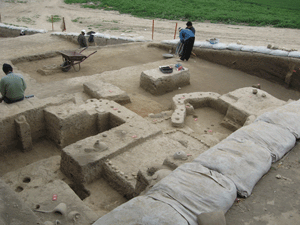
New studies shed light on lifestyle at Gohar-Tappeh prehistoric site
A team of Iranian and Polish anthropologists working at Gohar-Tappeh have recently found some amazing facts about lifestyles at the region in three millenniums BC.
Located five kilometers west of Behshahr in Iran’s northern province of Mazandaran, Gohar-Tappeh is the largest and most important prehistoric site so far, relative to those previously discovered in the region.
A joint team of German and Iranian archaeologists along with a number of Polish experts in interdisciplinary fields have recently been assigned to study the 13,000 year record of habitation at the site.
The new anthropological studies are led by Arkadiusz Soltysiak, an expert from the Department of Historical Anthropology at the Institute of Archaeology at Warsaw University, the Persian service of CHN reported on Saturday.
Studies on skeletons unearthed from graves at the site indicated that men living in the region were large in stature and powerful, Iranian director of the team Ali Mahforuzi said.
“The studies determined that the people had a rich diet, consisting mostly of marine animals due to their proximity to the Caspian Sea,” he explained.
He said that in their diet, they also enjoyed eating meat from roebucks, deers, bulls, pigs, hedgehogs and birds like ducks. However, the people included few vegetables in their diet.
Consequently, the people suffered from a shortage of iron, which sometimes cost them their lives. Some of the people may have also died as a result of infectious diseases caused by polluted water.
The experts have also learned that the people of the region were very skilful horsemen.
“Studies on the pelvises and the leg bones of the skeletons have taken a special shape as a result of their serious pursuit of equitation,” Mahforuzi stated.
Horses had been tamed long before the early habitation was established in the Gohar-Tappeh region, but the apparent intensity of the people’s admiration for the animal has surprised the experts, he said.
“Perhaps due to its regular use and its close contact with the people, the animal was viewed as being sacred,” Mahforuzi noted.
“This is conjectured because many horse statuettes, sometimes in rhyton-shaped artifacts, have been found at the ruins of the religious monuments discovered at Gohar-Tappeh,” he added.
This is the first instance since the victory of Iran’s 1979 Islamic Revolution that such a large-scale research project is being carried out in Iran.
